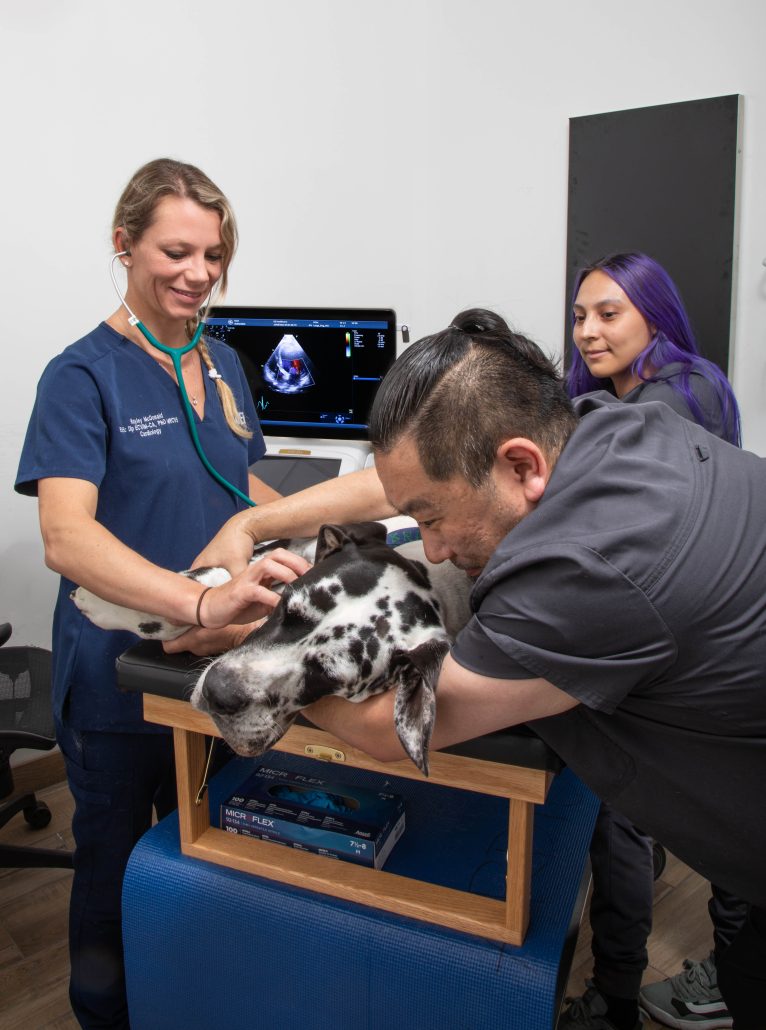The Function of Ultrasound and CT Check in Modern Vet Practices: Insights From Experienced Professionals
In modern veterinary practices, ultrasound and CT scans significantly enhance diagnostic abilities. These imaging methods give vital insights into animal health and wellness, assisting treatment decisions. Experienced professionals identify the distinct benefits of each modality. Ultrasound supplies real-time assessments, while CT scans provide intricate physiological details. Comprehending their duties and applications elevates essential concerns concerning their effect on patient outcomes and the future of vet diagnostics. What understandings can be gained from their combined usage?
Comprehending Ultrasound in Vet Medication
Ultrasound is a necessary analysis tool in vet medicine, using a non-invasive technique to imagine internal structures. This imaging strategy uses high-frequency acoustic waves to produce real-time pictures of organs and cells, enabling vets to examine conditions without medical intervention. Common applications include examining the heart, liver, kidneys, and reproductive body organs, in addition to keeping an eye on pregnancies.The procedure is relatively fast and can be carried out in numerous settings, making it an accessible alternative for veterinarians. Unlike radiography, ultrasound supplies comprehensive information about soft cells and blood flow, which is crucial for precise diagnoses.Veterinary professionals count on ultrasound to spot problems such as tumors, cysts, and liquid buildup. Its capability to guide biopsies and other procedures additionally enhances its energy in medical technique. By using a risk-free and effective way to take a look at internal anatomy, ultrasound has actually come to be a foundation of contemporary veterinary diagnostics.
The Advantages of CT Scans for Pet Diagnostics
CT checks offer substantial advantages in veterinary diagnostics by supplying enhanced precision in determining interior conditions (Cancer Veterinary Near Me). As a non-invasive imaging technique, they ensure the security and convenience of pets throughout assessments. Furthermore, CT checks promote a complete evaluation of internal structures, enabling for more reliable treatment planning
Enhanced Diagnostic Accuracy
Developments in imaging innovation have substantially boosted analysis accuracy in veterinary medication, especially through the usage of CT scans. These scans supply comprehensive cross-sectional images of an animal's internal frameworks, allowing veterinarians to determine abnormalities with accuracy. The high resolution and three-dimensional abilities of CT imaging help with the detection of problems such as lumps, fractures, and internal blood loss that could be missed out on with traditional imaging methods. Additionally, CT scans can assist in pre-surgical preparation by providing a comprehensive sight of physiological connections. This degree of detail not just improves the precision of medical diagnoses yet likewise help in customizing efficient treatment plans. The combination of CT modern technology right into veterinary methods is changing the landscape of pet healthcare, enhancing results for clients.
Non-Invasive Imaging Method
The introduction of non-invasive imaging strategies has actually transformed animal diagnostics, with CT checks emerging as a famous device in vet practices. These scans give high-resolution, cross-sectional photos of an animal's interior structures, permitting veterinarians to assess complex conditions without the requirement for invasive treatments. The benefits of CT scans include their ability to discover tumors, fractures, and inner bleeding with amazing precision. Furthermore, they promote the analysis of soft tissues and organs, enhancing analysis abilities. The speed of CT scanning makes it possible for quick decision-making, which is vital in emergency circumstances. By lessening stress and discomfort for the animal, CT scans add to a much more humane method to diagnostics, ultimately enhancing therapy end results and progressing vet care.
Comprehensive Internal Assessment
A thorough inner analysis is crucial for exact diagnosis and effective treatment in veterinary medication. CT checks deal substantial advantages hereof, offering detailed cross-sectional photos of a pet's inner frameworks. This advanced imaging method enhances visualization of complex anatomical regions, enabling veterinarians to determine problems such as tumors, fractures, and interior bleeding with greater precision. Additionally, CT checks facilitate the analysis of conditions that might be testing to identify via conventional techniques. The rate and precision of CT imaging also add to timely interventions, boosting individual outcomes. As vet practices progressively incorporate CT technology, the advantages of comprehensive internal analyses end up being obvious, reinforcing the significance of this tool in modern veterinary diagnostics.
Contrasting Ultrasound and CT Imaging Techniques
While both ultrasound and CT imaging offer crucial duties in vet diagnostics, each technique uses distinctive advantages and constraints that can affect medical decision-making. Ultrasound is especially valued for its real-time imaging abilities, enabling veterinarians to observe dynamic physical procedures. This strategy is non-invasive, portable, and does not involve ionizing radiation, making it a more secure alternative for both animals and clinicians. However, ultrasound may have restrictions in picturing certain anatomical structures or deep tissues.Conversely, CT imaging provides detailed cross-sectional sights of the body, allowing for accurate localization of abnormalities. It excels in examining complicated organs and structures, particularly in the thorax and abdominal area. Nevertheless, CT scans call for sedation or anesthetic in most cases and involve exposure to ionizing radiation. Eventually, the selection in between ultrasound and CT depends upon the certain professional situation, the area of passion, and the urgency of the analysis needs.
Instance Researches: Effective Diagnoses Through Imaging
Study illustrate the significant improvements in diagnostic precision attained via sophisticated imaging modern technologies like ultrasound and CT scans in veterinary practices. These developments not only boost the detection of different conditions however additionally facilitate prompt and effective therapy plans. Analyzing certain cases can highlight the transformative impact of these imaging methods on veterinary medicine.
Diagnostic Accuracy Improvements

Imaging Modern Technology Advancements
As vet imaging innovation proceeds to advance, its effect on analysis abilities comes to be significantly noticeable. Current instance research studies highlight the successful application of advanced ultrasound and CT scan methods in identifying complicated conditions. For example, a vet facility utilized high-resolution CT scans to diagnose a rare type of lung cancer in a dog, which standard imaging had missed. An ultrasound assessment revealed a stomach mass in a feline, triggering prompt surgical intervention and a favorable outcome. These improvements not only boost analysis precision but likewise make it possible for veterinarians to devise targeted therapy plans. By leveraging cutting-edge imaging modern technologies, veterinary specialists are considerably boosting More Help person treatment, resulting in much more effective monitoring of numerous health and wellness conditions in animals.
The Function of Imaging in Emergency Situation Vet Treatment
Imaging plays an essential function in emergency situation vet treatment, supplying vets with vital details required to make quick, enlightened decisions. In urgent situations, methods like ultrasound and CT scans enable practitioners to quickly examine an animal's inner structures, determining important problems such as internal bleeding, cracks, or body organ abnormalities. These imaging methods permit real-time assessments, assisting in timely interventions that can be life-saving. Ultrasound is indispensable for evaluating soft cells injuries and conditions like fluid build-up, while CT checks offer detailed photos of intricate anatomical frameworks, essential for identifying trauma cases. The rate and accuracy of these imaging techniques boost the vet's ability to create effective therapy plans, ensuring the very best possible outcomes try this out for their individuals. Consequently, the assimilation of innovative imaging innovations into emergency situation veterinary practices is not only beneficial yet significantly required, as it improves analysis capabilities and boosts general pet treatment throughout vital minutes.
Training and Experience in Vet Imaging
Innovative imaging methods such as ultrasound and CT scans are crucial for efficient vet treatment, the effective execution of these modern technologies heavily depends on the training and expertise of veterinary specialists. Proficient usage of imaging tools needs thorough understanding of anatomy, pathology, and the principles underlying each technique. Vet specialists have to undergo specialized training to accurately analyze imaging results, which is crucial for detecting conditions and planning treatment.Certifications and proceeding education and learning in vet imaging enhance the abilities of practitioners, allowing them to stay upgraded with technological improvements. Collaboration in between vets and radiologists commonly leads to enhanced analysis accuracy, as experts can provide insights right into complicated situations. In enhancement, sensible experience in dealing with imaging tools promotes confidence in its application. Inevitably, the high quality of veterinary imaging services is straight correlated to the level of training and experience had by the experts utilizing these crucial analysis tools.
Future Trends in Diagnostic Imaging for Animals
With the quick advancements in modern technology, veterinary analysis imaging is poised for considerable evolution in the coming years. Arising trends show a shift in the direction of even more available and mobile imaging modalities, such as portable ultrasound devices, which might enhance field diagnostics. In addition, the combination of synthetic knowledge is expected to revolutionize photo evaluation, permitting quicker and extra accurate interpretations of results.Moreover, developments in 3D imaging methods and calculated tomography will certainly offer vets with more thorough views of pet makeup, causing enhanced treatment plans. Digital reality technology may additionally contribute in surgical planning and education and learning, providing veterinarians a special viewpoint on complicated cases.As telemedicine continues to expand, remote assessments facilitated by analysis imaging will become extra typical, permitting experts to help family doctors in real-time. On the whole, these patterns are set to improve the effectiveness and performance of veterinary care, inevitably boosting animal end results.
Frequently Asked Concerns
Just How Much Do Ultrasound and CT Checks Price in Veterinary Centers?
The prices of ultrasound and CT scans in vet facilities typically range from $300 to $1,500, relying on variables such as area, center type, and specific procedures required for the animal's medical diagnosis and treatment.

Exist Any Dangers Connected With Ultrasound and CT Checks for Pet Dogs?
Ultrasound and CT scans normally present marginal threats to family pets. Nonetheless, potential worries consist of sedation reactions and exposure to anesthetics. CT Scans For Animals. Vets very carefully evaluate each case to alleviate any type of risks related to these analysis treatments
Just How Long Do Ultrasound and CT Treatments Usually Take?
Ultrasound procedures normally take about half an hour to an hour, depending on the intricacy. CT scans, being more comprehensive, typically call for half an hour to 90 minutes, including prep work and recovery time for the pet.
Can All Veterinarians Perform Ultrasounds and CT Scans?
Not all vets can perform have a peek at this site ultrasounds and CT scans. Specialized training and certification are commonly required to assure expertise in these advanced imaging techniques, which may restrict their schedule to veterinarians with additional certifications and resources.
What Sorts Of Pets Profit Many From These Imaging Techniques?
Particular animal species, specifically pet dogs and felines, advantage greatly from ultrasound and CT scans. These imaging techniques enhance diagnostic accuracy for problems like lumps, internal injuries, and organ irregularities, resulting in improved therapy results and client treatment. The high resolution and three-dimensional capacities of CT imaging facilitate the detection of conditions such as growths, cracks, and inner bleeding that might be missed with traditional imaging techniques. Situation researches show the significant renovations in diagnostic precision accomplished through sophisticated imaging innovations like ultrasound and CT scans in vet techniques. Improving analysis precision in veterinary methods has actually been substantially assisted by advancements in imaging technologies such as ultrasound and CT scans. Advanced imaging techniques such as ultrasound and CT scans are essential for reliable vet care, the effective application of these modern technologies greatly depends on the training and knowledge of vet professionals. Vet experts must undergo specialized training to properly translate imaging outcomes, which is important for diagnosing conditions and intending treatment.Certifications and proceeding education and learning in vet imaging enhance the abilities of practitioners, allowing them to stay updated with technological advancements.